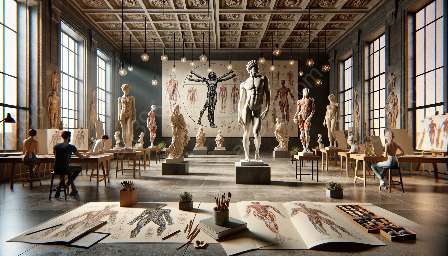The Renaissance was a period of great artistic and anatomical innovation that revolutionized the way in which the human body was depicted in art. At the heart of this transformative era was the renowned artist Michelangelo, whose exceptional sculptures not only showcased his artistic talent but also reflected a profound understanding of human anatomy. This article will explore Michelangelo's sculptures in the context of the anatomical innovations of the Renaissance, shedding light on the interconnectedness of art and science during this pivotal time in history.
Michelangelo: Master Sculptor and Anatomist
Michelangelo Buonarroti, widely regarded as one of the greatest artists of all time, made substantial contributions to the world of sculpture during the Renaissance. His sculptures, such as the iconic 'David' and the awe-inspiring 'Pieta,' exemplify his unparalleled skill in capturing the human form with remarkable anatomical accuracy. However, Michelangelo's mastery extended beyond artistic prowess; he possessed a deep fascination with the intricacies of human anatomy, often dissecting cadavers to gain a comprehensive understanding of the body's structure.
Michelangelo's keen interest in anatomy enabled him to imbue his sculptures with a sense of vitality and physical realism that was unprecedented in his era. His profound understanding of musculature, skeletal proportions, and the dynamics of movement elevated his works to new heights, setting a standard for anatomical accuracy that inspired countless artists and anatomists in the centuries to come.
The Influence of Renaissance Anatomical Innovations
During the Renaissance, a groundbreaking shift occurred in the depiction of the human body in art. This era saw a resurgence of interest in human anatomy, fueled by the pioneering anatomical studies of figures like Andreas Vesalius and Leonardo da Vinci. The dissection of human cadavers and the exploration of the body's inner workings led to a more nuanced and scientifically informed representation of anatomy in art.
Artists, inspired by these anatomical discoveries, sought to portray the human form with greater accuracy and naturalism. The newfound knowledge of muscular and skeletal structures allowed for more lifelike and dynamic representations, as seen in the works of Michelangelo and his contemporaries. The interplay between art and anatomy during the Renaissance laid the foundation for a more profound understanding of the human body, ultimately shaping the course of artistic expression for centuries to come.
The Artistic Anatomy of Michelangelo's Sculptures
Michelangelo's sculptures embody a harmonious fusion of artistic brilliance and anatomical precision. Each work reflects an acute awareness of anatomical detail, showcasing the artist's meticulous study of the human form. The musculature, proportions, and gestures depicted in his sculptures convey a profound understanding of anatomy, captivating viewers with their lifelike realism.
One of Michelangelo's most celebrated sculptures, 'David,' epitomizes his mastery of artistic anatomy. The sculpture's poised stance, sinewy muscles, and expressive physicality demonstrate Michelangelo's ability to capture the human body's essence with unparalleled accuracy. 'David' stands as a testament to the artist's profound grasp of anatomical structure, solidifying his reputation as a unparalleled sculptor and anatomist.
The Legacy of Renaissance Artistic Anatomy
The impact of Renaissance anatomical innovations on art reverberates throughout history, shaping the evolution of artistic anatomy as a discipline. The meticulous study of human anatomy became integral to artistic training, enabling artists to imbue their works with heightened realism and emotional depth. The fusion of art and science during the Renaissance laid the groundwork for a more profound understanding of the human body, fostering a legacy that continues to inspire artists and anatomists to this day.
In conclusion, the sculptures of Michelangelo and the Renaissance's anatomical innovations stand as a testament to the interconnectedness of art and science. Through his unparalleled mastery of artistic anatomy, Michelangelo not only transformed the art world but also fueled a renaissance in the understanding of human anatomy. This era of convergence between art and anatomy set the stage for a new chapter in the history of artistic expression, leaving an indelible mark on the course of human creativity and exploration.

